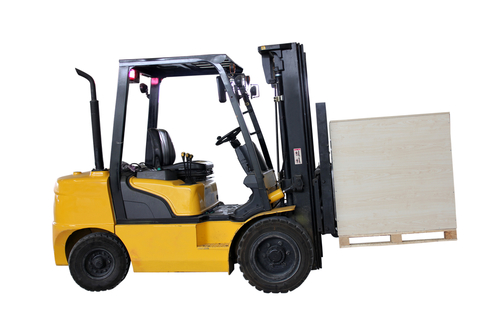Forklift operations raise many safety issues for employers. There’s a lot to know about OSHA requirements, and not all of it is well-known. Many of your colleagues have turned to our safety experts for answers to their safety forklift questions.
 |
Here’s a sample of interesting forklift questions sent in to our sister website, Safety.BLR.com®, where subscribers are guaranteed an answer to their safety questions within 3 business days.
Q. I don’t see any part of 1910.178 that states forklift operators need to wear hard hats. Are there any other references for mandating the use of hard hats while operating a forklift?
A. Under 1910.132, OSHA requires that a hazard assessment be performed to determine when personal protective equipment is necessary. This would include forklift operations.
Workers must wear hard hats where there is a potential for objects falling from above, bumps to their heads from fixed objects, or accidental head contact with electrical hazards. See Safety.BLR.com’s regulatory analysis on head protection and PPE-General for more information.
Q. Are forklifts required to have mirrors on them? What about backup signals (horns or lights)?
A. The following is from an OSHA letter of interpretation:
We agree that backup alarms are not specifically addressed in the regulations of 29 CFR parts 1910 — General Industry, 1917 —- Marine Terminals, or 1918 —- Longshoring. Backup alarms are required on certain vehicles in 29 CFR Part 1926 — Safety and Health Regulations for Construction.
Please be advised that there are two Maritime regulations, 29 CFR 1917.43(c)(5) and 29 CFR 1918.65(f), that prohibit removal or disconnection of safety devices on [powered] industrial trucks. Thus, if the [powered] industrial truck is equipped with a backup alarm, the alarm cannot be removed or made inoperative.
The same situation would apply to mirrors. If the mirrors are part of the original equipment of the forklift, they must not be removed. However, they are not specifically required by the powered industrial truck standard, 29 CFR 1910.178.
Q. Do we have to retrain our employees if we have changed from propane forklifts to electric forklifts?
A. Yes. Please see the following excerpt from the Powered Industrial Trucks Standard:
29 CFR 1910.178(l)(4)(ii)
Refresher training in relevant topics shall be provided to the operator when:
29 CFR 1910.178(l)(4)(ii)(D)
The operator is assigned to drive a different type of truck.
Q. What is required for medical fitness for work or fitness evaluation to operate a fork truck?
A. Federal OSHA has no requirement for medical evaluations for forklift operators.
Q. What is the minimum clearance for a forklift to pass under an overhead conveyor?
A. There are no specific rules for clearances between machines and forklifts. Federal OSHA provides the following guidance concerning clearances between forklifts and other machines:
“Providing sufficient clearance for mechanically moved materials will prevent workers from being pinned between the equipment and fixtures in the workplace, such as walls, racks, posts, or other machines. Sufficient clearance also will prevent the load from striking an obstruction and falling on an employee.”
Use your best judgment to determine the clearance that will achieve the goals of this guidance. Many facilities post warning signs with clearances in potentially high-hazard areas. Include a description of these hazard areas with any forklift operator training.
Q. What is the frequency required by OSHA for forklift inspections—daily or each 8-hour shift?
A. According to 29 CFR 1910.178(q)(7), “Industrial trucks shall be examined before being placed in service, and shall not be placed in service if the examination shows any condition adversely affecting the safety of the vehicle. Such examination shall be made at least daily. Where industrial trucks are used on a round-the-clock basis, they shall be examined after each shift. Defects when found shall be immediately reported and corrected.”
Q. Do you need a valid driver’s license to operate a forklift?
A. There is no requirement in 29 CFR 1910.178 that a forklift operator have a valid driver’s license.

PingBack from http://topsy.com/tb/bit.ly/6ZcdW
This post was mentioned on Twitter by BLR_EHS: Safety Daily: Your Forklift Questions Answered: Forklift operations raise many safety issues for e.. http://bit.ly/6ZcdW
Question.. The horn due to failure has been relocated from the steering wheel area to a location where it is hard to get at ..where at times it is nearly impossible to operate the forklift and get at the horn without having both hands off the steering wheel.. Is there a requirement for horn location or modification ?
WHEN DID IT BECOME LAW TO BE CERTIFIED ON FORKLIFTS?
Does forklift has side mirror? If no please tell me why.
Hi there
I work in a secure location with gates at the entry by my self driving a fork lift. Do I need to wear safety clothers
Allan